We motored west on I-8 back to Gila Bend. It was sunny and gorgeous and in the high 50’s by the time we got there and we had a nice low key afternoon in the warm trailer. The next morning, we called ahead to KOFA KO-OP SKP park in Yuma (a place we’ve stayed 3 times) only to find that they were full. More and more places that a year or two ago had availability (but were close to capacity) are now full most of the time so it’s worth calling ahead when we can. No problem there are lots of places in Yuma. So we got out our Passport America book and decided we’d try Fortuna de Oro RV Resort on the east side of Yuma in the Yuma Foothills area. They have over 1000 spots so we figured they’d have something for us. We headed west on I-8 and sure enough when we arrived at Fortuna de Oro they had plenty of spots. The place is right off of I-8 so we asked to be as far from the freeway as possible and they obliged us with a nice corner spot out by the golf course where you couldn’t hear the freeway at all inside or out. We got a full hook up back-in site for just $20.81 a night with our Passport America membership.
About 2/3’s of the spots in this resort are filled with park models—small single-wide houses that have to be under 400 sq feet to meet the requirements of being viewed as RV’s by the zoning laws. They’re installed like a single-wide (but they have wheels) but are zoned like trailers. Many have an additional room added on called an Arizona room that gives folks another 120 to 200 sq feet. People spend 4 to 6 months living in them during the winter. There were lots of Canadians here escaping winter!
We decided initially that we’d stay 3 days so we could do laundry, grocery shopping and errands and plan the next few days of travel. By the time we’d gone through the weather reports and done some planning we opted to stay 4 days. They had decent WiFi (it worked most of the time though occasionally it was really slow) but no cable TV. Walter managed to get some decent TV over the air though.
After lunch we loaded up the empty propane tank and drove to a gas station that could fill it—exciting yes? Having solved that problem we came home and Walter had a nap! That evening we had a nice fiery sunset.
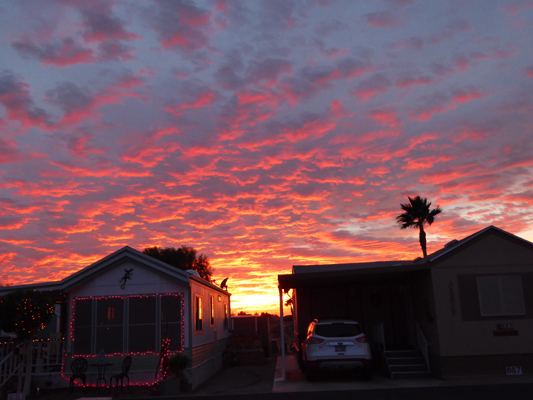
Those are park models across the street from us.
Wednesday December 28th, we took it slow (a major treat as far as I was concerned) and then loaded the laundry up and found the laundry room. Wash and dry were only $1.25 each (on the cheap end of things for most parks) and there were washers available—whoo hoo. It had been nearly 2 weeks since we’d had someplace to do laundry so I had 4 large loads to do and it was a major undertaking. But in time we were done and could take the rest of the afternoon off.
On Thursday, we did errands and had a look at the park models just to understand what it was that attracted folks to them. Space-wise they’re like small cottages or a decent sized one-bedroom apartment—big in comparison to our Airstream but still pretty small. The folks who’ve added the Arizona room basically have a two bedroom place with laundry in a closet—not bad. And I managed to get a photo of the Castle Dome Mountains to the east while we were out and about.
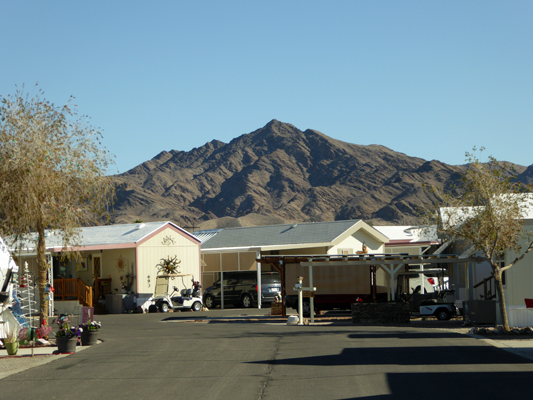
We actually had a couple of days where nothing broke or went sideways which was refreshing after a couple of weeks of challenges and we even got a few things repaired too. Having decided to stay a fourth day, on Friday December 30th we headed north on Hwy 95 to visit the Castle Dome Mine Museum.
Along the way I shot a photo of the Castle Dome Mountains across the Yuma Proving Grounds.
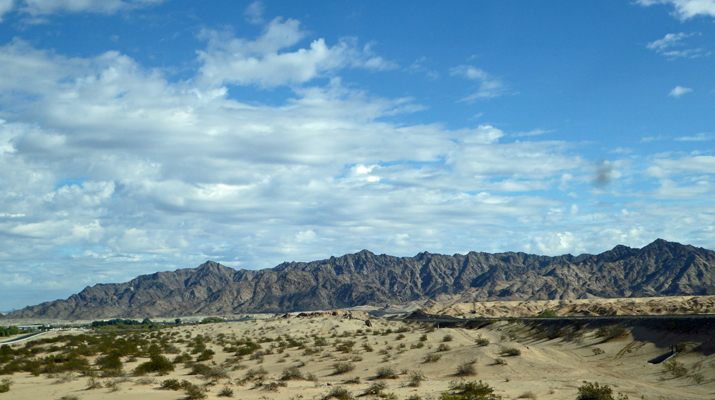
To get to Castle Dome City you have to drive east Castle Dome Road (off of Hwy 95) through a portion of the Yuma Proving Grounds and into the Kofa Wildlife Refuge. The refuge encompasses 664,327 acres of desert bighorn sheep habitat running from up by Quartzsite to just a few miles north of Yuma. We did a hike in the refuge 2 years ago out to Palm Canyon (up towards Quartzsite) where the only native palms in all of Arizona grow.
We stopped as we entered the wildlife refuge to read the signs and to take a photo of the mountains from Castle Dome on southward.

Castle Dome is that odd volcanic plug on the left hand side. A bit further right is Thumb Butte and then the rest of the mountains.
We continued out the dirt road (no washboard thank goodness) to a little pocket of private land surrounded by the wildlife refuge. There we had a great view of Castle Dome.
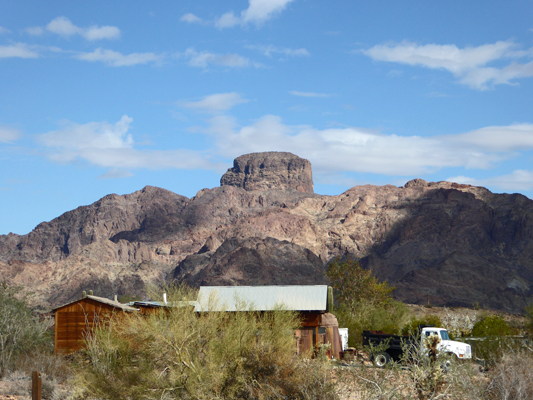
In the pocket of private land (at the end of the road) we found the Castle Dome Mining Museum—a collection of buildings that have been moved to the town of Castle Dome City as a way of preserving as many of the old buildings and other memorabilia from the Castle Dome Mine District as possible. The owner of the Castle Dome Mine created the museum because the administrators of the Kofa Wildlife Refuge were planning on removing all the buildings to return the area to it’s natural state, so why not move them all together to save them? The he filled the buildings up with all the ‘stuff’ that folks left behind. It’s a pretty amazing collection.
Entry fee is $10 per person and allows you to explore the ‘town’ and its contents plus explore a portion of the original mining district just south of the museum. The museum is full of fun stuff like the remains of old cars
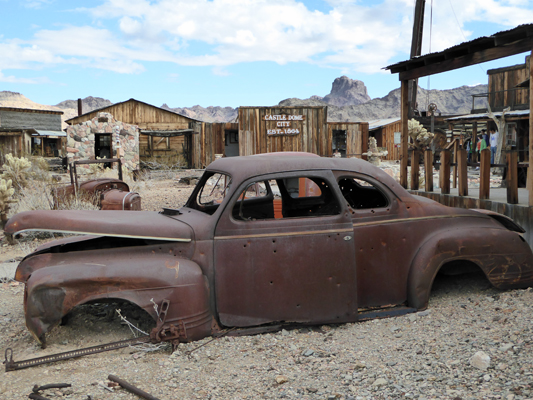
Old Remington typewriters (there are several here and there in various buildings)
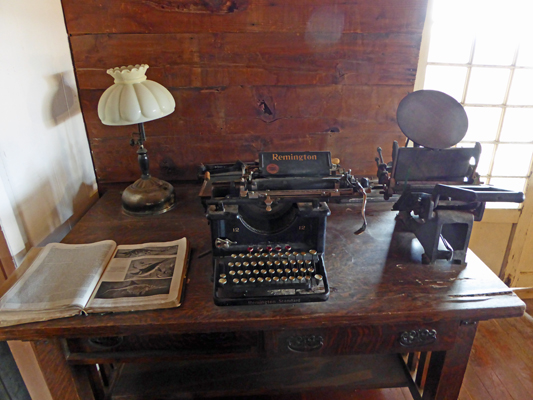
And a player piano complete with the boxes of music rolls to make it play.
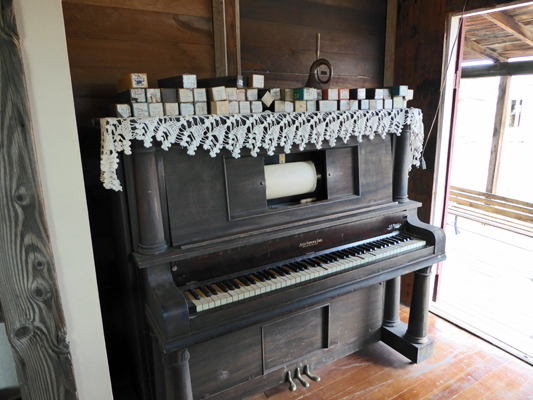
The buildings include everything from a little bank
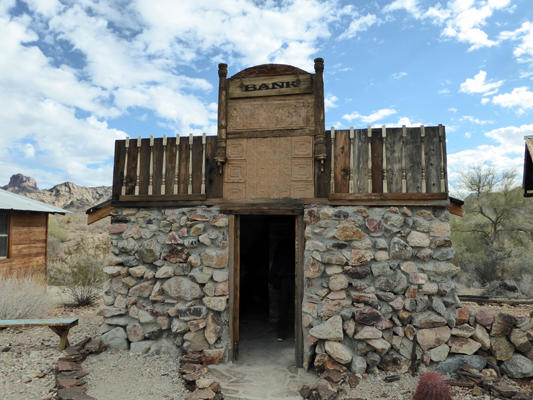
Complete with the teller’s cage and safe and stamped tin ceiling
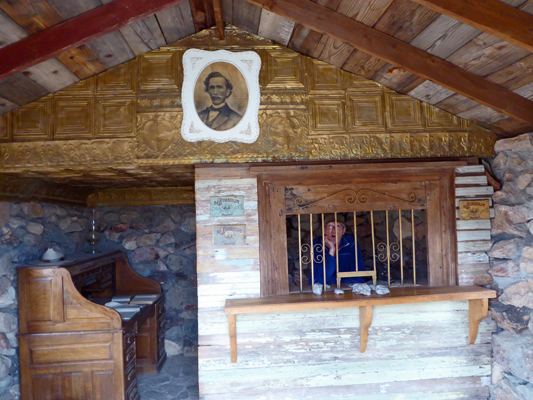
And several bars and this great saloon in the old hotel with more tin ceiling
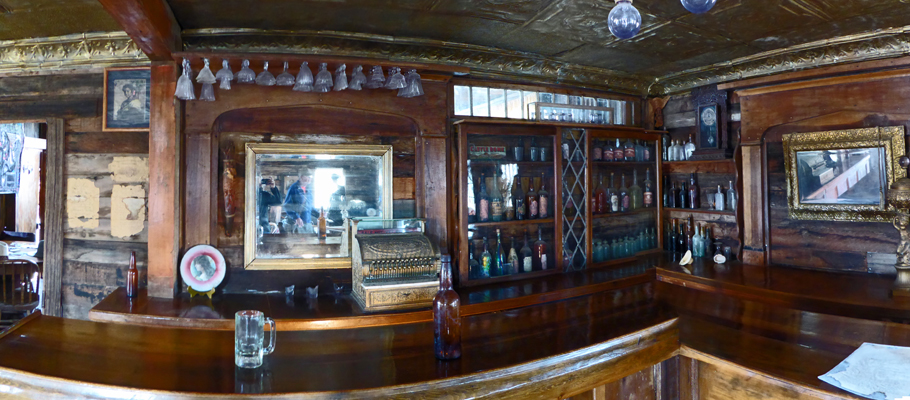
There are barber shops, dentists offices and even a doctor’s office.
There’s a school and a mercantile with all sorts of funs stuff including this great wood cook stove.
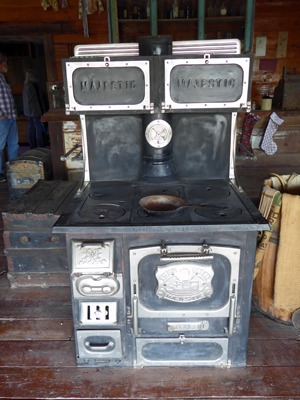
We had a great time exploring the place as did all the other folks who had made their way out there for the day. The stone building on the left (with Castle Dome behind it) is Walt’s Barber Shop—I couldn’t resist including it. I don’t know how big Castle Dome City was back in its hey day but it’s full of buildings now with everything a town could need from a blacksmiths shop to a church.
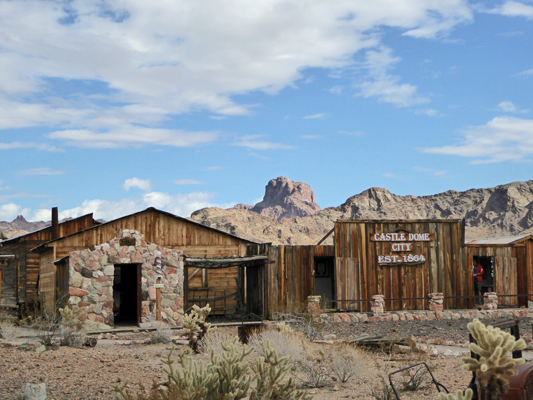
After exploring the town we drove the short distance south to explore the Castle Dome Mine District—complete with signage made from old car/truck doors.
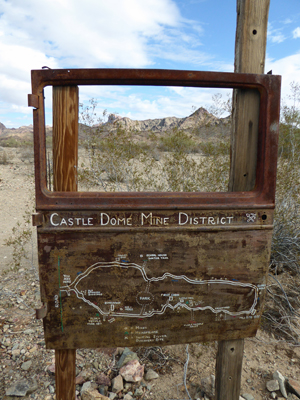
There were over 300 mines in the Castle Dome Mine District. Most of them were holes in the ground that didn’t go very far. But a few were deep enough to require a head frame to haul the men and the ore back up out of the mine. The Flora Temple Mine head frame isn’t huge like the ones we saw in Butte Montana a few years ago but it did its job. As you can see, the mouth of the mine (adit) isn’t that big.
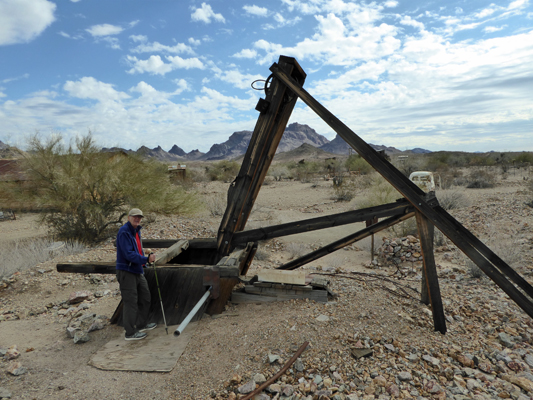
There’s a bigger head frame up by the original Castle Dome Mine itself too.
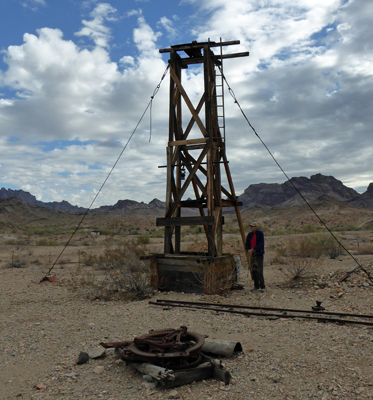
They mined silver and lead here from 1868 until 1980—when the price of silver topped out and dropped back down to current levels. The old Glory Hole produced a lot of silver. By 1873, 5000 tons of silver galena (lead and silver) ore was shipped to Shelby Smelter in San Francisco yielding 200,000 ounces of silver.
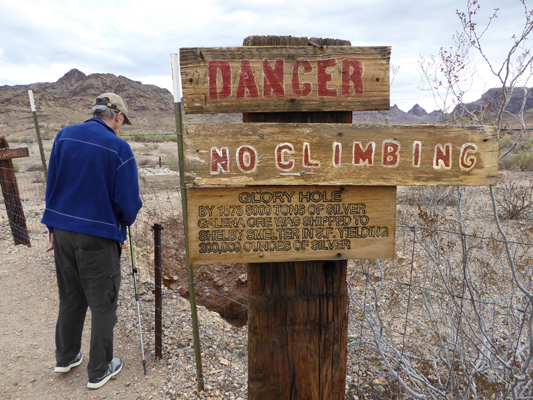
And it all came out of this hole. And no, they don’t let you go down and explore (thank goodness).
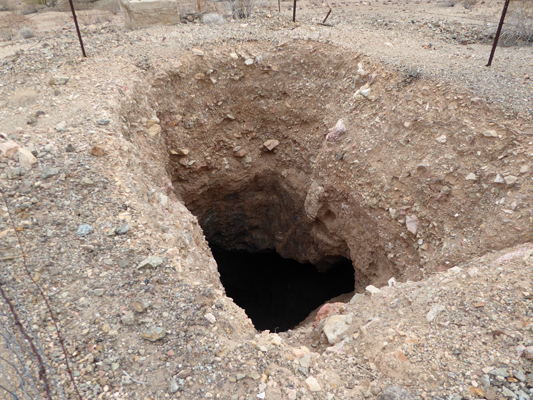
Outside the boundaries of the hike, you can see the remnants of mines everywhere—some, just holes in the ground others with equipment still standing.
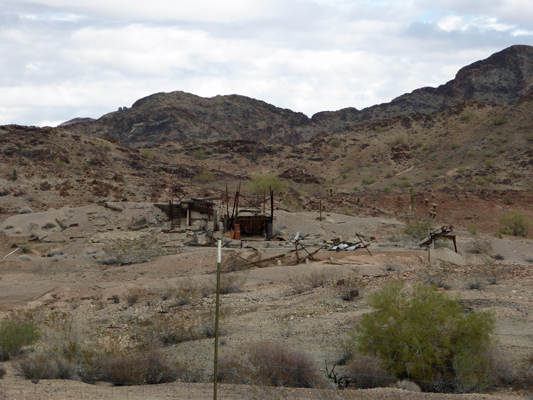
Having hiked the trail and enjoyed the history we headed back into the wildlife refuge for our lunch. The clouds were coming in and it looked like it might rain soon. Two years ago when we were camping down this way, we’d learned about the Tethered Aerostat Radar System that they operate on the Yuma Proving Grounds. We’d seen it aloft as we drove in and then as we were hiking it looked like they were bringing it down—in preparation for the weather perhaps.
As we drove west through the wildlife refuge we spied it parked in the desert.
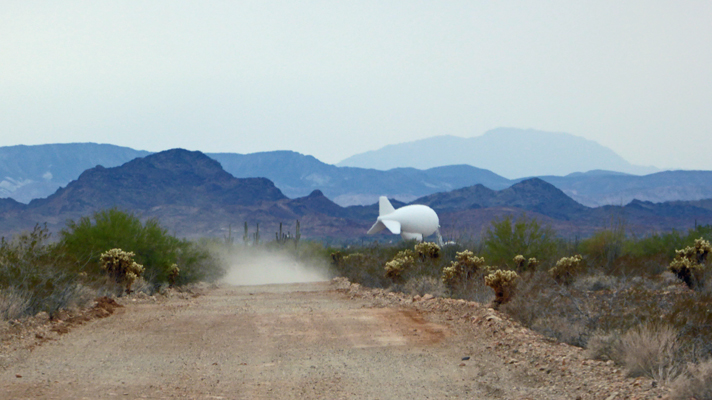
And when we stopped for lunch at the parking area just inside the refuge, it turned out that the aerostat was moored right across the road in the Proving Grounds.
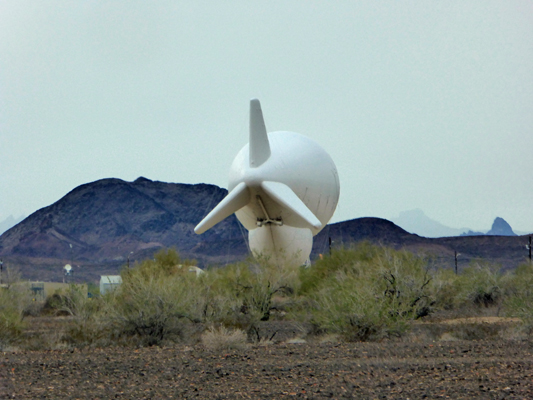
By the time we’d finished with lunch, it had started to sprinkle but at least it waited to begin raining in earnest until we were back on the pavement and headed down Highway 95 towards home. It rained for a few hours and then cleared off at the horizon just at sunset. The sky turned bright yellow since we still had clouds overhead but the sun was out in the clear sky to the west. It wasn’t very photogenic but it sure was strange looking.
On Saturday December 31st, we packed up and drove 100 miles west on I-8 to Rio Bend RV Resort just west of El Centro. We’d made a reservation and asked specifically to NOT be near the pool since last year when we’d stayed here in March we’d had a very noisy spot right opposite the pool—with much golf cart traffic and noise from a party by the pool. With it being New Years Eve we thought we’d rather be further out in the park. They gave us a nice spot in an area that was over half empty and with some difficulty (too many palm trees too close to the parking spots) we got parked and set up. With our Passport America membership we paid $25 a night for a back-in full hookup site with high end cable (ESPN so Walter could watch the UW Huskies play Alabama in the Peach Bowl) and decent free WiFi that worked pretty well the whole time.
It was in the mid 70’s and we had the door and some of our windows open all afternoon. Heaven. Then late in the afternoon the clouds came in and we had rain by dinner time with thunder and lightening by 10 pm—Mother Nature’s Fireworks for New Years. Having just changed time zones we didn’t make it to midnight in Pacific Time but we did watch the ball drop in New York at 9 pm and made it to midnight in Mountain Time.
On New Years Day we had expected that Walter would spend the day watching college bowl games. But no, the NFL owns Sunday so there were no college bowl games on at all. There was nothing but pro football. Ah well. So in the late morning when the temperature was a lovely 65 degrees with a light breeze we took a walk around the Rio Bend RV Resort just to stretch our legs (and keep me from getting restless). At the end of our row, you could see across the road to an enormous field of broccoli.

The Imperial Valley is the source of most of the broccoli, cabbage, cauliflower and lettuce for the country during the winter months and there are miles and miles and miles of fields full of crops.
On the north side of the park there’s a nice little pond. Two years ago we had a farm goose with an injured wing who stood and honked for hours next to the pond.
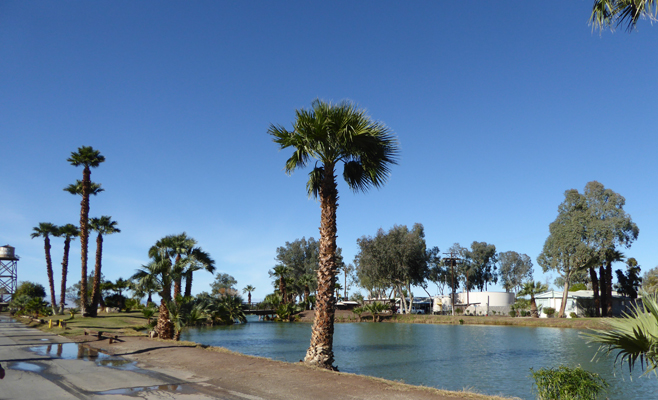
This time there was a small flock of domesticated Swan Geese (I had to look them up on the internet because they’re not in my bird book).
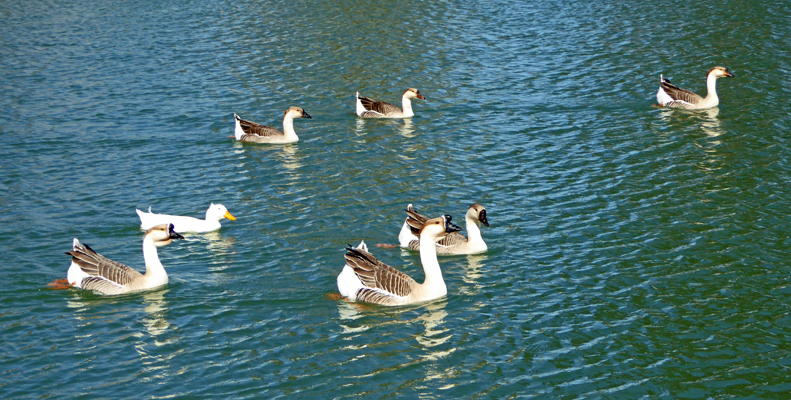
They are an Asian goose that has been domesticated and you can recognize them from the funny little lump on their noses.
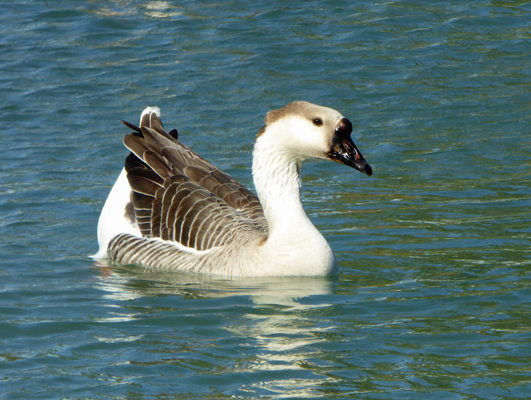
There’s a golf course at the edge of the park and we walked the edge enjoying the green. The spot where we camped last time which was so noisy now has a park-owned park model on display in it. This place doesn’t have as many park models as Fortuna de Oro did but clearly they’re starting to push them here since they have sales info up.
At the southern edge of the park you get a view of Signal Mountain down by the Mexican border.
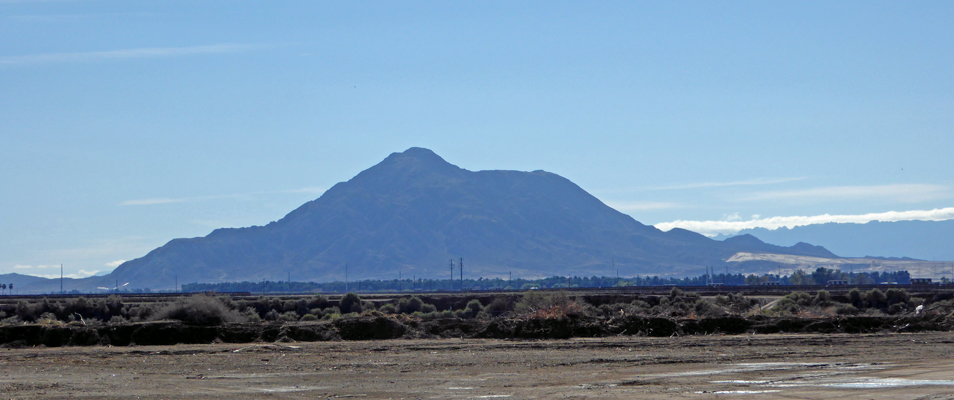
I hope this finds you all well and happy. May the new year bring you joy and peace.
